My So-Called Life at 30
The eleventh episode of My So-Called Life (1994-1995) includes a brief but influential scene that I have returned to repeatedly over the years since it first aired: Rickie Vasquez (Wilson Cruz), a queer Latinx teenager at Liberty High School, dances with Delia Fisher (Senta Moses) at the World Happiness Dance. Honestly, one two-minute segment from a short-lived 1990s television should not have this kind of staying power. Yet here I am, three decades later, still thinking about it. Though fleeting, this scene transcends its original context — for me and for countless queer viewers — lodging itself in our cultural memory as an all-too-rare symbol of courage and kinship on television. Decades later, as the thirtieth anniversary of the show's cancellation draws near, Rickie's dance endures as an iconic example of how popular media can cultivate radical visibility and solidarity, even as it grapples with a rather complex politics of representation.
This scene marks a critical moment in television history, particularly given its historical and cultural context. Before Pose (2018-2021) showcased ballroom culture or Heartstopper (2022-) mainstreamed queer teen romance on television, we had Rickie Vasquez figuring himself out on cable television. As a groundbreaking character for 1990s television, Rickie challenged the stereotypical and tokenized portrayals of queer figures that dominated the era. Unlike the flamboyant "gay best friend" trope found in later shows like Will & Grace (1998-2006) or the strictly tragic narratives of queer youth found in after-school specials, Rickie is a nuanced, multi-dimensional character whose identity resists easy categorization. Indeed, his brief existence as a character transformed how queer and racialized characters are depicted on television.
I find this moment striking for reasons that go beyond mere nostalgia. When I watch Rickie dancing with Delia, I see a rare television moment that creates space for marginalized people to breathe and connect. Drawing on José Esteban Muñoz's idea of the "Brown commons," I see this dance sequence bringing everyone—including Rickie's peers and viewers like me—into a shared moment of resistance against the usual limitations television places on queer and Latinx characters.1 Still, this scene is not a simple celebration. Even as Rickie claims space on the dance floor, something complicated exists in his partnership with Delia, the white girl who ends up following his lead. Specifically, this moment reveals how gendered and racial hierarchies persist even within these liberatory contexts. It functions as a microcosm of larger social struggles, while its influence reaches beyond its cultural moment and historical period to prompt us to question what representation itself can and cannot accomplish.
Navigating Liberty High School
As Liberty High School prepares for the World Happiness Dance (possibly the most ironic name for a high school event filled with teenage angst), a number of tensions come to a head, exposing the complex — and often unspoken — social dynamics that play out within the student body. Rickie, for example, hesitates to attend; his reluctance reflects the challenges of navigating a white, heteronormative school environment where his identity often leaves him feeling both exposed and out of place. In a parallel storyline, new student Delia Fisher is abandoned by the socially awkward Brian Krakow, who ditches her to pursue his long-standing crush, Angela Chase. Angela, the introspective main character of My So-Called Life, similarly finds herself torn between a desire for authenticity and her entanglement in the high school's rigid social expectations.
As a character, Rickie stands in stark contrast to other queer representation found in 1990s television series. While shows like Melrose Place (1992-1999) occasionally featured gay characters who were defined primarily by their sexuality and often subjected to tragic storylines, and sitcoms like Friends (1994-2004) and Roseanne (1988-1997) used gay characters primarily for comic relief (with a few lovely and usually momentary exceptions), Rickie exists as a fully-realized person who must navigate intersecting identities. Unlike those other characters, Rickie grapples with homelessness, family rejection, and the struggle of finding community across race and class lines in ways that make his queerness dynamic. Through these challenges, we witness Rickie's sexual and gender expression evolve — sometimes muted for self-protection, sometimes boldly expressed through makeup and fashion, and occasionally functioning as a bridge to connect with others who recognize his authentic self. In other words, his queerness is not static but a living, adaptive identity that responds to different social contexts. The complexity of his character refuses the flattening that typically occurred in 1990s television, where queer characters — when they appeared at all — were often reduced to single-episode "very special" storylines or comedic stereotypes. It is this consistent depth-of-character that led me to purchase the box set on VHS after I graduated high school, and still leads me back to this episode decades later.
The dance, therefore, becomes a critical moment in both Rickie's and Delia's journeys. Seeing Delia standing alone after being abandoned by Brian, Rickie spontaneously asks her to dance, immediately transforming the dance floor into a space of mutual support and self-expression. Their movement draws both attention and admiration, temporarily disrupting the established social order. This moment reflects what Juan Antonio Suárez describes as "untried relationality and difference."2 For Suárez, memory — often fragmented and multisensory — becomes a means of navigating oppressive present conditions and envisioning queer futures. He refers to these processes as a "brown memory commons," a framework that borrows from Muñoz to foreground collective acts of remembrance as generative, porous, and transcorporeal.3 Through their dance, Rickie and Delia embody these transformative possibilities, demonstrating how difference and solidarity can reshape cultural memory.
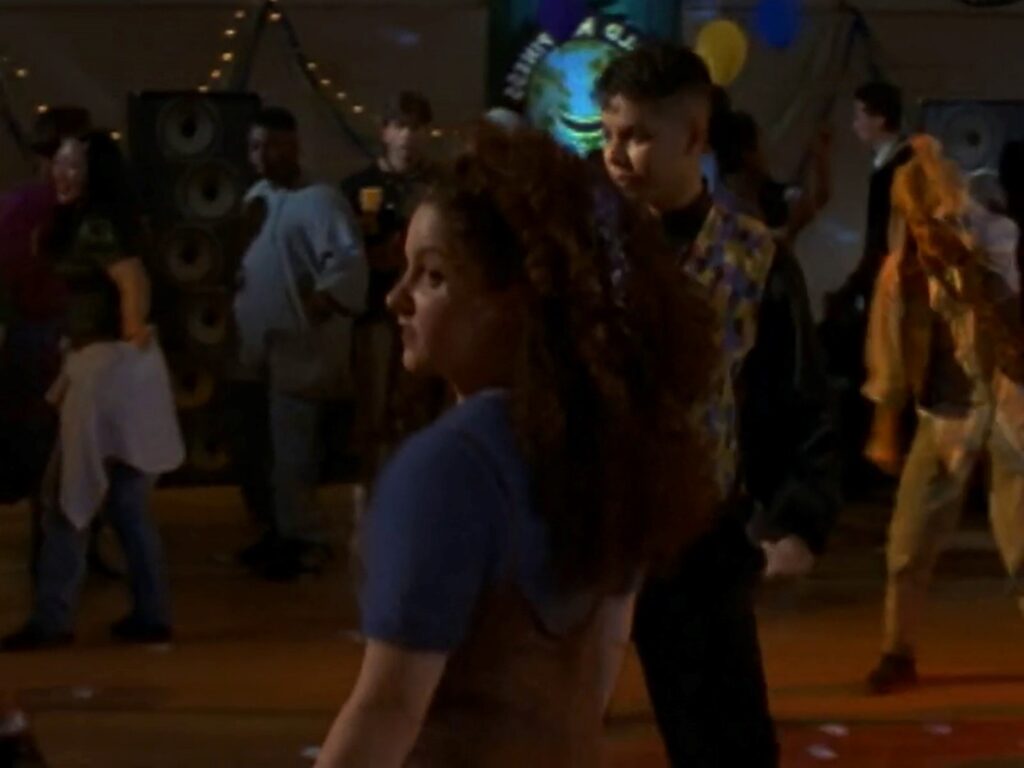
Belonging and the Brown Commons
Through this scene, Rickie embodies Muñoz's concept of brownness, which "arrives at us" and performs in ways that resist being fully knowable.4 This performance creates a ripple effect beyond his individual experience, turning the dance floor into what Muñoz might view as a communal experience rather than a solo act. Indeed, as Muñoz notes, brownness manifests not as a fixed identity but through its actions in the world, creating moments of connection, rupture, and defiance against normative structures. Just as Muñoz invokes "us" instead of "I" in his description of the Brown commons, Rickie's act of defiance quickly transforms into a collective performance rather than an individual one. When Rickie invites Delia to join him, he shifts from isolated visibility to creating a collective moment where others can participate in this form of resistance. The dance becomes a means through which Rickie generates a plural vision of both selfhood and community, inviting others to join him in an expanded sense of belonging.
These theoretical concepts come together in the dance scene, where Rickie's performance unites personal identity with collective resistance. By dancing with Delia, another figure at the margins of social hierarchy, Rickie exemplifies Muñoz's notion of "feeling brown in a world painted white."5 The school dance becomes an arena where Rickie negotiates his identity against the demands of white cultural conformity. This visible defiance challenges pressures to assimilate or fade away, enacting a powerful mode of "feeling brown" that disrupts normative expectations of race and identity.
Yet this resistance contains its own complications. As Rickie leads in their dance, a certain gendered and racialized hierarchy emerges; he anchors the scene as the queer Brown boy who knows how to move, while she, a white girl, follows his direction. This dynamic both subverts and reinscribes traditional power structures. Rickie gains momentary authority through his cultural knowledge and performance skills, but this authority still depends, in part, on Delia's willingness to follow and validate him. I cannot help but notice how this mirrors broader patterns in which white culture often celebrates marginalized identities while maintaining structural dominance.
That said, through movement, Rickie confronts both racial and heteronormative structures, transforming his body from a site of exclusion into a beacon of resistance. In The Sense of Brown, Muñoz describes nightlife as a "zone where the affective dominance of white normativity is weakened."6 The high school dance, like Muñoz's nightlife spaces, serves this transformative function for Rickie and Delia, creating a space where the "freaks come out," where marginalized identities can thrive beyond normative constraints.7 Still, the question remains: whose liberation is prioritized in this commons? While Rickie finds some level of freedom and joy through dance, his role as choreographer and leader places him in a position of having to perform for others, a burden not equally shared by all those who inhabit this temporary commons.
Rickie's dance with Delia quickly evolves from a performance of self-expression into an act of resistance. Both Delia's reaction to his uninhibited movements, and the gaze of others around the dance floor signal that his performance (which I will describe in detail below) falls outside the established conventions of white heteronormativity. Muñoz writes that "brownness is a kind of uncanny persistence in the face of distressed conditions of possibility,"8 a concept manifested as Rickie navigates his hostile social environment. Rickie and Delia enact a solidarity that transcends individual identity. Their shared movement aligns with Muñoz's conception of brownness as fluid and performative—understood through its expression in the world, or a "sense of being-in-common" that is "transmitted across people, place, and spaces."9 Rather than articulating a singular identity, their dance represents brownness as a process of connection. Indeed, Delia becomes affectively Brown here, reflecting how brownness operates relationally and emerges through moments of connection and resistance.
With this in mind, it is all the more fitting that the two characters dance to Haddaway's "What is Love?" a Euro-dance earworm that could be heard everywhere in 1994. While MTV was turning the track into ubiquitous pop culture, Rickie and Delia end up reclaiming it for something more intimate. Indeed, the song's simple, repeated plea echoes exactly what plays out between them: "Can I be seen? Can I belong?"10 That their bodies find rhythm against this institutional backdrop transforms what could have been just another dated musical reference into something unexpectedly powerful. The commercial gloss of the track ultimately collapses into something rawer: a borrowed anthem for those brief moments when vulnerability wins out over fear.
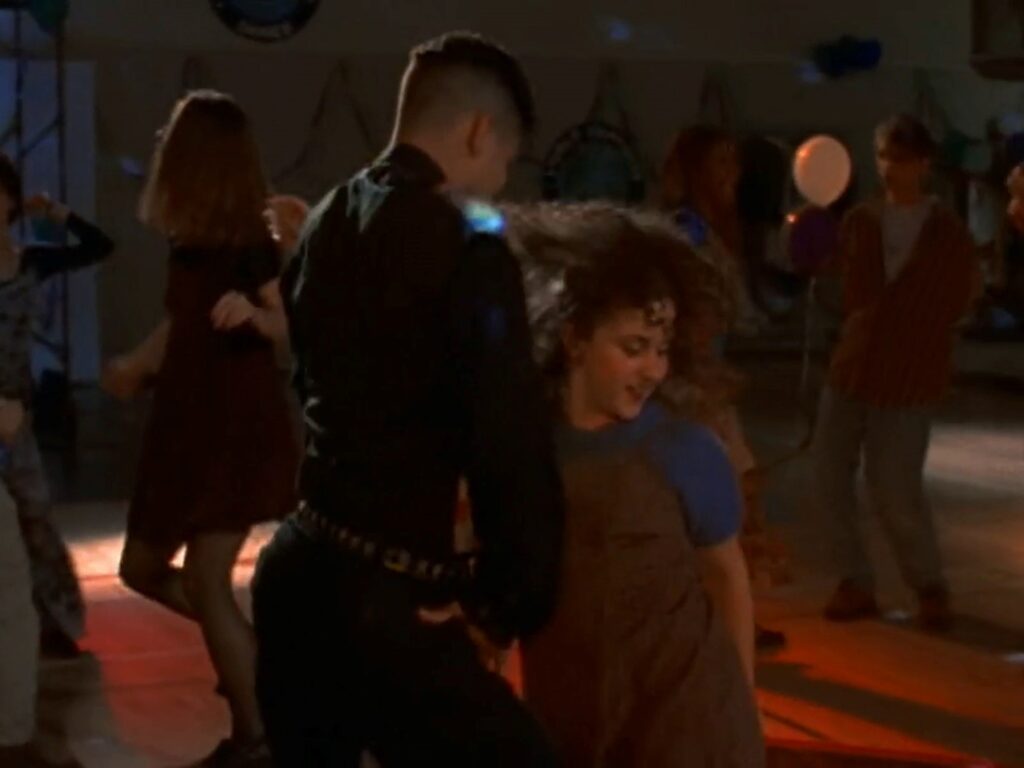
The dance creates a momentary Brown commons, a space where marginalized identities unite against dominant structures. Muñoz's concept applies perfectly, encompassing both "shared experiences of harm" and "potential for the refusal and resistance to that often-systemic harm."11 Rickie's dance embodies this refusal, reclaiming visibility within a space designed to marginalize him and transforming the dance floor into a temporary site of liberation within the white, heteronormative institution. In doing so, he extends relational access to this space, inviting others to belong alongside him.
Delia's role in this scene reinforces the relational nature of brownness. Although she does not possess an overtly Brown identity, her participation illustrates the fluid and communal nature of brownness as a performative state. Indeed, her status as a white girl who has been socially marginalized on the basis of body type and being new to the school complicates the dynamics of the Brown commons that Rickie creates. Still, as Muñoz explains, "brownness is about contact and is nothing like continuousness. Brownness is a being with, being alongside."12 The dance between Rickie and Delia exemplifies this notion, as they move beyond being isolated subjects to create a shared sense of belonging. Their connection illuminates Muñoz's insight that "knowing a brownness that is our commonality" only emerges through relational acts rather than individual expressions.13 In dancing together, Rickie and Delia renegotiate their social positions and gesture toward a communal potential that defies isolation. The dance floor thus becomes a microcosm of the Brown commons, a space where solidarity and connection triumph over exclusion.
Choreographing Resistance
Rickie's choreography plays a key role in this transformation through rhythm, fluidity, and improvisation. His movements disrupt typical high school dance patterns — the slow swaying and careful hand placement characteristic of heteronormative partnering. The camera captures his resistance to these conventions, following his body as it shifts from controlled, self-conscious movements to increasingly bold and expressive gestures. Rickie's shoulders loosen first, followed by his hips, until his entire body becomes a vehicle for uninhibited expression. His eyes, initially looking around him with uncertainty, eventually meet Delia's gaze with confidence, creating a mutual recognition that transforms their dynamic.
Through spontaneity and joy, Rickie challenges the unspoken rules of school-sanctioned spaces, asserting his presence through uninhibited expression rather than conformity. The cinematography contrasts his improvisation with the structured movements of other students, underscoring his rejection of social scripts. This tension reveals how visibility for queer, Latinx people often demands active performance rather than passive acceptance.
This resistance manifests itself through specific choreographic choices: chest pops, hip rolls, and spins purposefully drawn from burlesque, hip-hop, and ballroom traditions, each rooted in histories of resistance and subversion. While "bump and grind" movements were common at 1990s school dances, Rickie's incorporation of voguing gestures, ballroom spins, and minor flourishes drawn from hip hop emphasizes his alignment with both queer and urban cultural traditions, even if his exposure to such moves was drawn from mainstream artists like MC Hammer or Madonna in her "Vogue" era. These movements resist the rigidity of the social roles imposed upon him, positioning his body as both a site of joy and one of defiance. His choreography expresses not just personal pleasure but a challenge to the norms that deny queer students of color access to such joy in public spaces.
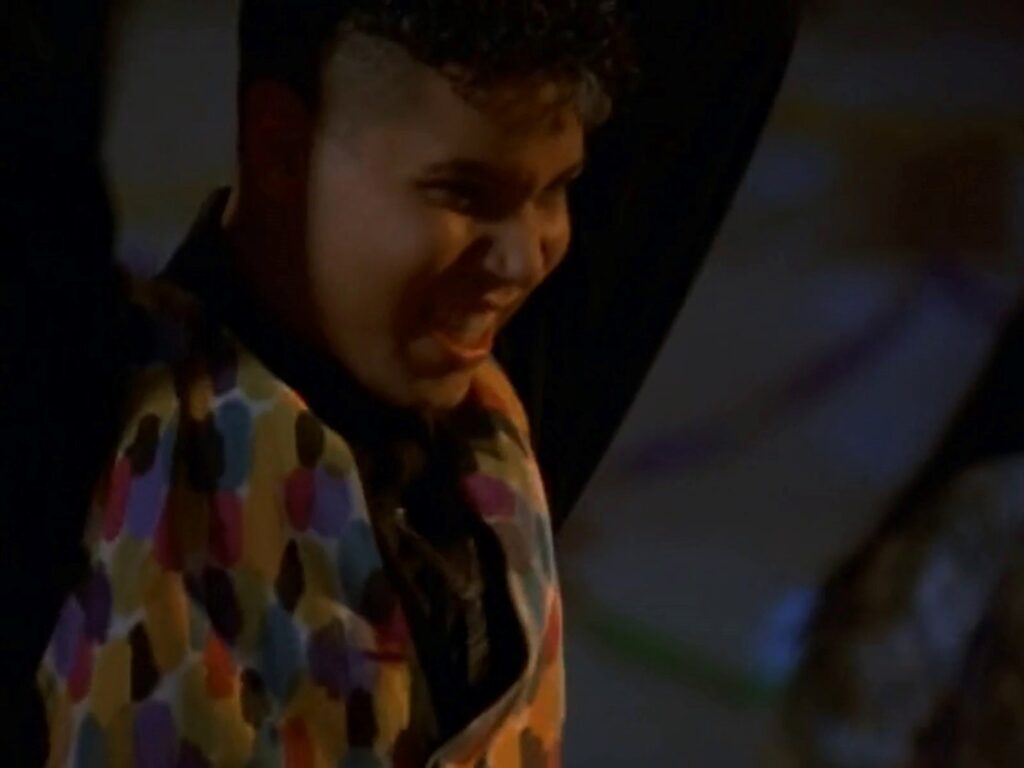
When Rickie's choreographic resistance joins with Delia's movements, their partnership transforms the dance floor into a temporary Brown commons — a space where difference is freely expressed and genuine connection flourishes. The scene traces Rickie's journey from periphery to center, from isolation on the stairs to claiming the heart of the social space, mirroring the broader struggle for belonging faced by marginalized individuals. As the camera pans to capture their bodies in motion, the softened lighting carves out an intimate space distinct from earlier moments. Their synchronized gestures suggest that belonging emerges through relational acts rather than predetermined social categories. Delia's presence, though not visually distinctive, proves essential in demonstrating the power of allyship. Together, they reimagine the dance floor as a site where conformity gives way to creative possibility and exclusion is met with joyful defiance. Their improvisation establishes an alternative rhythm that transcends expectations, celebrating connections that emerge through collaboration. Although temporary, their shared performance offers a glimpse of liberation, showing how resistance, joy, recognition, and belonging can be forged in spaces initially designed to exclude.
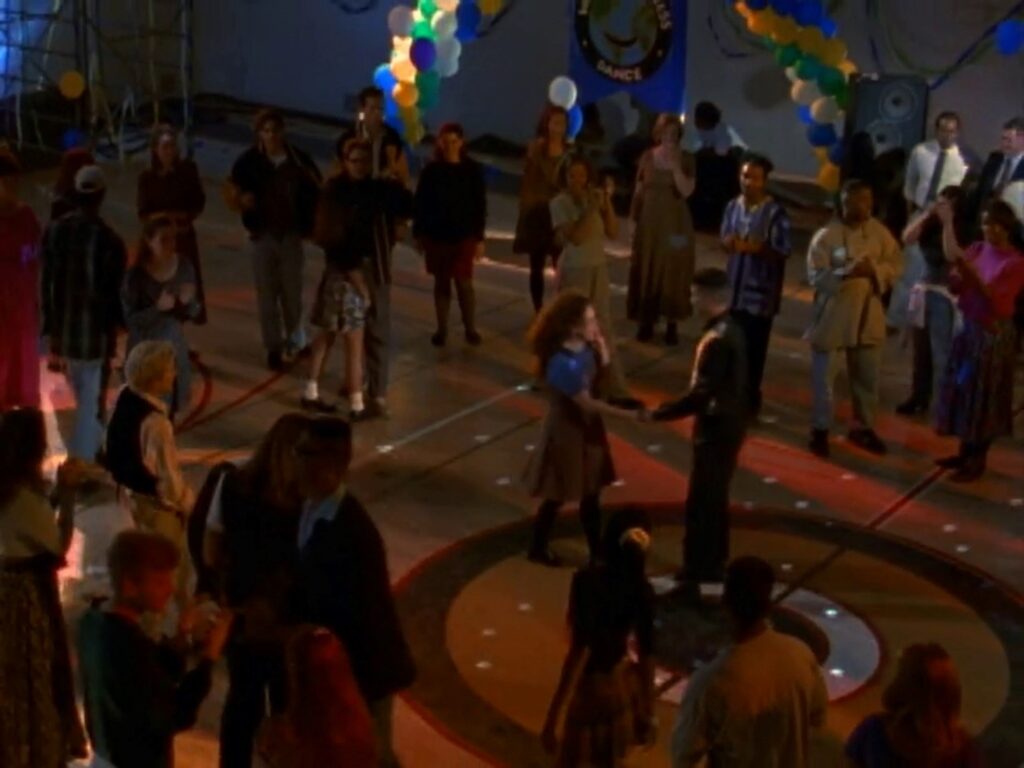
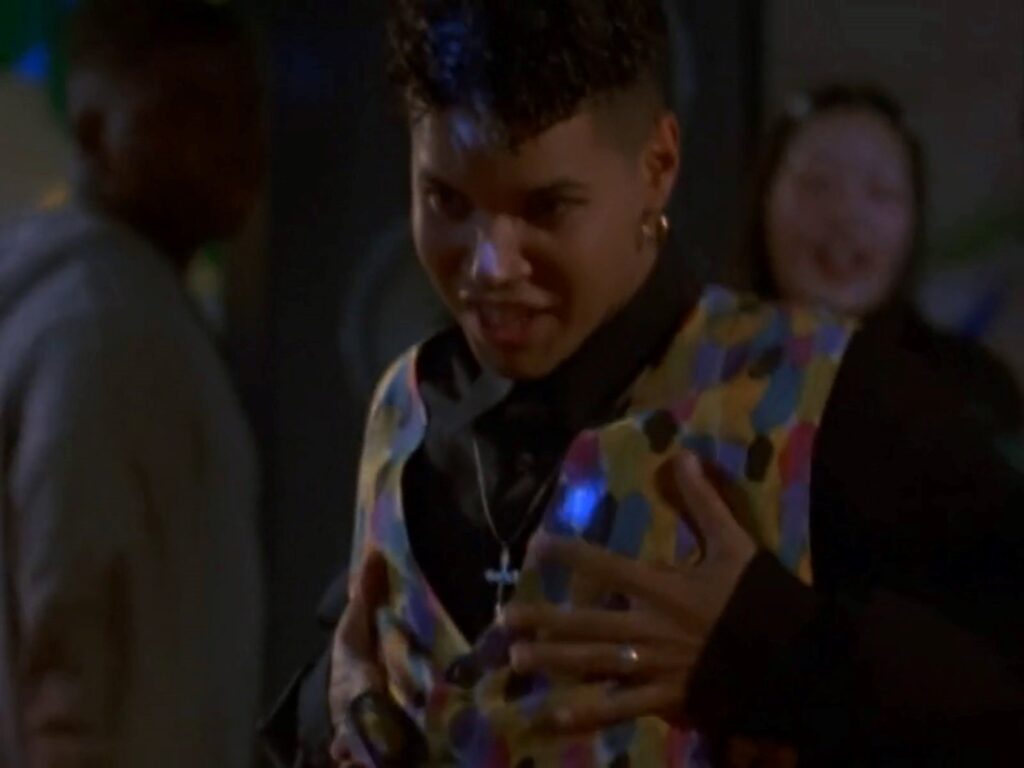
The Affective Politics of Memory
Rickie's dance carries significance beyond his immediate performance, persisting in cultural memory through its continued circulation. The visibility he achieves becomes more than a singular instance of recognition, evolving into an emotional and relational act whose influence reaches far beyond the high school dance floor.
While the dance scene offers a powerful vision of resistance and connection, it remains temporary; it is a brief interruption of normative social structures rather than a permanent transformation. When the music stops, Rickie must return to navigating a world that continues to marginalize him. The ephemeral nature of this liberation recalls Sara Ahmed's exploration of emotions, discomfort, and "stickiness." Ahmed calls it "stickiness," but we might also call it "haunting," as it has that quality of certain cultural moments to stay with you forever.
Ahmed's theoretical framework helps explain the scene's lasting impact. She posits that emotions are not confined to internal psychological states but exist within social and cultural practices, shaping relationships between bodies, objects, and spaces. As she writes, "emotions are not simply something 'I' or 'we' have. Rather, it is through emotions, or how we respond to objects and others, that surfaces or boundaries are made — even as these redrawn boundaries remain precarious."14 Through this lens, Rickie's dance operates as a social intervention, challenging the emotional architecture of the school dance by redrawing boundaries and forging new modes of interaction. His movement disrupts the normative frameworks governing participation, transforming a space of confinement into one of possibility.
I am always struck by the labor that Rickie must perform in order to create this space of belonging — a burden placed disproportionately on marginalized bodies. His dance, in other words, is both an act of resistance and a performance that is required for survival. Much like the way marginalized communities must often navigate hostile environments through code-switching and performance, Rickie must dance exceptionally to earn even momentary acceptance. Meanwhile, other students, particularly white students like Sharon Cherski and Kyle Vinnovich, can simply exist without this additional labor. This disparity reveals how even liberatory spaces can reproduce certain forms of inequality.
Moreover, the power of this scene is derived, in part, from its exceptionality — a quality that might inadvertently reinforce the norms it seeks to disrupt. While I find myself celebrating this scene over and over again through the years, I also realize that celebrating its singularity as a moment of queer Brown visibility, I risk overlooking the systemic conditions that make such moments rare. I often need a reminder that the utopian potential of this dance should not blind me to the structures that require such performances in the first place.
Ahmed's exploration of discomfort and disorientation highlights how Rickie's dance challenges the social norms of the event. She writes, "to be comfortable is to be so at ease with one's environment that it is hard to distinguish where one's body ends and the world begins."15 Rickie's presence, marked by race, queerness, and nonconformity, interrupts the seamless functioning of the dance, calling attention to the limits of the social order. His inability to disappear into the background makes his body a site of tension, resisting absorption into the normative space. Rather than smoothing over this discomfort, Rickie performs it through dance, turning it into a refusal of the expectations that govern participation. By inhabiting the space on his terms, he becomes a living critique of the emotional and social structures that define high school dances.
This experience of discomfort is not simply endured but transformed into a generative force that enables collective connection. As Ahmed explains, "discomfort is a feeling of disorientation: one's body feels out of place, awkward, unsettled."16 Rickie's dance reflects this disorientation but converts it into a mode of resistance, reconfiguring his relationship to the environment through movement. In doing so, he temporarily establishes a "Brown commons," a territory outside the constraints of normative identity politics. This moment, therefore, is not merely an escape from exclusion but a political act that transforms the dance floor into a site for alternative forms of belonging. Ahmed's concept of queer discomfort emphasizes that this invitation to connect across difference challenges the assumptions regulating bodies and emotions within the high school setting, creating opportunities for new forms of identity to emerge.
Ahmed's concept of emotional "stickiness" explains why Rickie's dance continues to move audiences decades after its broadcast. She notes that "some signs . . . increase in affective value as an effect of the movement between signs: the more they circulate, the more affective they become, and the more they appear to 'contain' affect."17 His dance, as an act of queer and racial defiance, gathers force through its presence in cultural memory, evolving into an enduring symbol of resistance. The scene's affective impact bridges generational gaps, allowing viewers across time to connect with Rickie. His dance carries the accumulated weight of ongoing struggles for visibility and belonging, serving as both archive and catalyst for resistance to exclusion and marginalization. The scene reaches beyond mere nostalgia to become a persistent reminder of the emotional and political work needed to challenge normative structures and nurture connection.
Dancing Beyond Boundaries
Ultimately, the dance shared by Rickie and Delia reveals how marginalized bodies can claim space and forge connections, leaving an enduring imprint on queer, Brown communities. By transforming the school dance — a traditionally heteronormative space — into a site of queer liberation, his performance challenges social hierarchies and creates pathways for expressing identity through the intersections of queerness and race. As I see it, this moment persists as a living blueprint, continually inspiring new forms of resistance and solidarity.
Rewatching this scene nearly thirty years after My So-Called Life was cancelled, I still find myself moved by how it captures a human hunger for belonging—the desire be seen by others. It is such a brief moment — barely two minutes — yet I cannot shake its portrayal of quiet defiance. Something about it reminds me of all the patient, invisible work that goes into creating safe spaces where people on the margins can breathe freely and flourish. The dance does not claim to revolutionize the world, of course. It does not try to. But for that fleeting moment, I glimpse what freedom might taste like, even as everything else remains stubbornly unchanged.
For me, the power of this scene lies in its dual nature; it is both a historical testament and utopian vision, where Ahmed's affective "stickiness" meets Muñoz's "Brown commons," inspiring audiences to imagine a more liberatory future. When I revisit this moment now, especially with frameworks that were not available to me when the episode first aired, I see both its potential and its limitations. For years, I thought this dance scene was revolutionary simply for showing a queer teenager on television. I was wrong. Or, more accurately, I was not seeing the whole picture. The dance does not solve structure problems of racism or homophobia, but it does show how resistance can emerge through joy, connection, and movement. It is that joy that clings to me three decades later.
Nicholas E. Miller (@uncannydazzler.bsky.social) is a scholar of comics, media, and popular culture who teaches at Mary Institute and Saint Louis Country Day School (MICDS). He received his Ph.D. in English from Washington University in St. Louis. Miller is editor of forthcoming collections that explore transmedia storytelling in K-pop and is a co-editor of the forthcoming Futures of Cartoons Past: The Cultural Politics of X-Men: The Animated Series. His award-winning scholarship has appeared in Feminist Media Histories and Inks: The Journal of the Comics Studies Society, with additional contributions to The Oxford Handbook of Comic Book Studies and Mixed-Race Superheroes. His scholarship primarily explores the intersections of identity, transmediality, and popular culture across comics, television, and music.
References
- José Esteban Muñoz, The Sense of Brown (Durham, NC: Duke University Press, 2020).[⤒]
- Juan Antonio Suárez, "Queer Memory and the Brown Commons," in Unbound: Queer Time in Literature, Cinema, and Video Games, ed. Juan Francisco Belmonte Ávila and Estíbaliz Encarnación Pinedo (London: Routledge, 2024), 129.[⤒]
- Suárez, "Queer Memory and the Brown Commons," 117-119.[⤒]
- Muñoz, Sense of Brown, 3.[⤒]
- Muñoz, Sense of Brown, 10.[⤒]
- Muñoz, Sense of Brown, 17.[⤒]
- Muñoz, Sense of Brown, 17.[⤒]
- Muñoz, Sense of Brown, 4.[⤒]
- Muñoz, Sense of Brown, 3.[⤒]
- Haddaway, What Is Love, Coconut Records, 1993, accessed April 8, 2025, https://open.spotify.com/track/7JkZ2hQdDonRURJjlMuh8q?si=127bbf0288c74187.[⤒]
- Muñoz, Sense of Brown, 4.[⤒]
- Muñoz, Sense of Brown, 2.[⤒]
- Muñoz, Sense of Brown, 2.[⤒]
- Sara Ahmed, The Cultural Politics of Emotion (Edinburgh: Edinburgh University Press, 2014), 10.[⤒]
- Ahmed, The Cultural Politics of Emotion, 148.[⤒]
- Ahmed, The Cultural Politics of Emotion, 148.[⤒]
- Ahmed, The Cultural Politics of Emotion, 45.[⤒]
